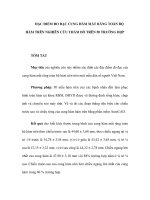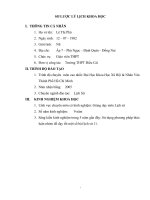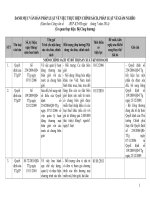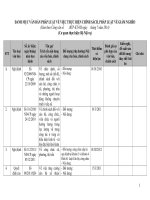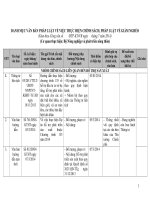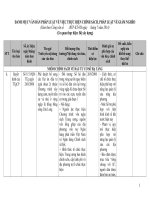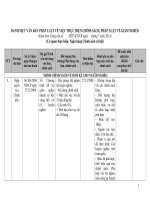Nghiên cứu thăm dò ý kiến từ giảng viên và sinh viên tiếng anh về nhận thức và thực hiện dạy học tự chủ
Bạn đang xem bản rút gọn của tài liệu. Xem và tải ngay bản đầy đủ của tài liệu tại đây (842.75 KB, 185 trang )
MINISTRY OF EDUCATION AND TRAINING
HUE UNIVERSITY
UNIVERSITY OF FOREIGN LANGUAGES
LE THANH NGUYET ANH
EFL TEACHERS’ AND STUDENTS’ PERCEPTIONS AND
PRACTICES REGARDING LEARNER AUTONOMY:
AN EXPLORATORY STUDY AT A VIETNAMESE
UNIVERSITY IN THE MEKONG DELTA
DOCTOR OF PHILOSOPHY THESIS IN THEORY AND
METHODOLOGY OF ENGLISH LANGUAGE TEACHING
HUE, 2019
MINISTRY OF EDUCATION AND TRAINING
HUE UNIVERSITY
UNIVERSITY OF FOREIGN LANGUAGES
LE THANH NGUYET ANH
EFL TEACHERS’ AND STUDENTS’ PERCEPTIONS AND
PRACTICES REGARDING LEARNER AUTONOMY:
AN EXPLORATORY STUDY AT A VIETNAMESE
UNIVERSITY IN THE MEKONG DELTA
DOCTOR OF PHILOSOPHY THESIS IN THEORY AND
METHODOLOGY OF ENGLISH LANGUAGE TEACHING
CODE: 9 14 01 11
1.
2.
SUPERVISORS:
Dr. TRUONG BACH LE
Assoc. Prof. Dr. DO MINH HUNG
HUE, 2019
BỘ GIÁO DỤC VÀ ĐÀO TẠO
ĐẠI HỌC HUẾ
TRƯỜNG ĐẠI HỌC NGOẠI NGỮ
LÊ THANH NGUYỆT ANH
NGHIÊN CỨU THĂM DÒ Ý KIẾN TỪ GIẢNG VIÊN VÀ
SINH VIÊN TIẾNG ANH VỀ NHẬN THỨC VÀ THỰC
HIỆN DẠY HỌC TỰ CHỦ ĐỐI VỚI SINH VIÊN CHUYÊN
NGÀNH TIẾNG ANH TẠI MỘT TRƯỜNG ĐẠI HỌC Ở
ĐỒNG BẰNG SÔNG CỬU LONG
LUẬN ÁN TIẾN SĨ
LÝ LUẬN VÀ PHƯƠNG PHÁP DẠY HỌC BỘ MÔN TIẾNG ANH
HUẾ, NĂM 2019
BỘ GIÁO DỤC VÀ ĐÀO TẠO
ĐẠI HỌC HUẾ
TRƯỜNG ĐẠI HỌC NGOẠI NGỮ
LÊ THANH NGUYỆT ANH
NGHIÊN CỨU THĂM DÒ Ý KIẾN TỪ GIẢNG VIÊN VÀ
SINH VIÊN TIẾNG ANH VỀ NHẬN THỨC VÀ THỰC HIỆN
DẠY HỌC TỰ CHỦ ĐỐI VỚI SINH VIÊN CHUYÊN NGÀNH
TIẾNG ANH TẠI MỘT TRƯỜNG ĐẠI HỌC Ở ĐỒNG BẰNG
SÔNG CỬU LONG
LUẬN ÁN TIẾN SĨ
LÝ LUẬN VÀ PHƯƠNG PHÁP DẠY HỌC BỘ MÔN TIẾNG ANH
MÃ SỐ: 9 14 01 11
NGƯỜI HƯỚNG DẪN KHOA HỌC:
1.
2.
TS. TRƯƠNG BẠCH LÊ
PGS.TS. ĐỖ MINH HÙNG
HUẾ, NĂM 2019
ACKNOWLEDGEMENTS
I have learnt, and experienced to become an autonomous learner throughout
my PhD course. I believe that this precious experience will help me with my
teaching process. Without my supervisors’, lecturers’, colleagues’, students’,
friends’ and family’s help, encouragements, and suggestions, the present thesis
would not have succeeded.
First of all, I would like to express my deeply sincere gratitude to my two
supervisors: Dr. Trương Bạch Lê and Assoc. Prof. Dr. Đỗ Minh Hùng for their early
suggestion of the topic, invaluable guidance, support and sincere advice throughout my
PhD journey. Both of them have supplied a large amount of their expert knowledge to me
and have helped me to change track completely to finish my thesis.
I am also heavily in debt to the staff of Hue University of Foreign
Languages: Assoc. Prof. Dr. Trần Văn Phước, Dr. Bảo Khâm, Assoc. Prof. Dr. Phạm
Thị Hồng Nhung, Assoc. Prof. Dr. Trương Viên, Assoc. Prof. Dr. Lê Phạm Hoài
Hương, Dr. Tôn Nữ Như Hương who provided me with critical, useful feedback to
help me conduct my thesis better. I would also like to thank Assoc. Prof. Dr. Lê Văn
Canh for his early advice and early suggestion of the title.
I also gratefully acknowledge my colleagues as well as my students in the
Faculty of Foreign Language Education at Dong Thap University who assisted,
understood, and supported me through my thesis.
My special thanks to my Mum, my husband, my brothers’ family, and my
friends for their love, encouragement, and being with me along my PhD course.
i
TABLE OF CONTENTS
ACKNOWLEDGEMENTS ................................................................................................
i
TABLE OF CONTENTS ..................................................................................................
ii
LIST OF ABBREVIATIONS ..........................................................................................
vii
LIST OF TABLES ...........................................................................................................
viii
LIST OF FIGURES............................................................................................................
ix
ABSTRACT .........................................................................................................................
x
Chapter One INTRODUCTION ......................................................................................
1
1.1 Background of the research .........................................................................................
1
1.2 Aims of the research .....................................................................................................
7
1.3 Research questions ........................................................................................................
7
1.4 Research significance ..................................................................................................
7
1.5 Organization of the thesis ...........................................................................................
7
Chapter Two LITERATURE REVIEW ........................................................................
9
2.1 Learner autonomy ........................................................................................................
9
2.1.1 Definition of learner autonomy.............................................................................
9
2.1.2 Roles of learner autonomy.....................................................................................
9
2.1.2.1 Learner autonomy in Asian EFL higher education ............................... …10
2.1.2.2 Learner autonomy in Vietnamese EFL higher education .........................
11
2.2 Learner autonomy in foreign language education ............................................. …12
2.2.1 Learner autonomy as ability ................................................................................
12
2.2.2 Learner autonomy as responsibility ...................................................................
13
2.2.3 Learner autonomy as cognitive processes .........................................................
15
2.2.4 Learner autonomy in lifelong learning ..............................................................
16
2.2.5 Learner autonomy as cultural challenge ............................................................
17
2.2.6 Learner autonomy in this study .........................................................................
20
ii
2.3 Aspects of learner autonomy ..................................................................................... 21
2.3.1 Technical aspect of learner autonomy ............................................................... 21
2.3.2 Psychological aspect of learner autonomy ........................................................ 22
2.3.3 Political aspect of learner autonomy .................................................................. 22
2.3.4 Sociocultural aspect of learner autonomy ......................................................... 23
2.4 Perceptions and practices .......................................................................................... 24
2.4.1 Perceptions ............................................................................................................ 24
2.4.2 Practices ................................................................................................................. 26
2.4.3 Relationship between perception and practice of learner autonomy ............. 30
2.5 Assessment as learning in learner autonomy........................................................... 31
2.5.1 Assessment as learning as an indispensable segment of LA........................... 31
2.5.2 Teachers’ role........................................................................................................ 33
2.5.3 Learners’ role ........................................................................................................ 35
2.6 Previous studies on EFL teachers’ and students’ perceptions and
practices of learner autonomy ................................................................................... 36
2.7 Summary ...................................................................................................................... 42
Chapter Three RESEARCH DESIGN AND METHODOLOGY .......................... 43
3.1 Research approach: Mixed methods research ......................................................... 43
3.2 Research participants .................................................................................................. 46
3.2.1 Teacher participants ............................................................................................. 46
3.2.2 Student participants .............................................................................................. 46
3.3 Data collection methods ............................................................................................. 47
3.3.1 Interviews .............................................................................................................. 48
3.3.1.1 In-depth interview .......................................................................................... 49
3.3.1.2 Group interviews ............................................................................................ 50
3.3.1.3 Interview for teachers .................................................................................... 51
3.3.1.4 Interview for students .................................................................................... 52
3.3.2 Questionnaire ........................................................................................................ 52
3.4 Research procedure ..................................................................................................... 57
iii
3.4.1 Pilot study............................................................................................................................... 57
3.4.2 Main study.............................................................................................................................. 58
3.4.3 Coding questionnaire and interview data.................................................................... 59
3.5 Data analysis................................................................................................................................. 59
3.5.1 Qualitative data analysis................................................................................................... 59
3.5.1.1 Transcribing data.......................................................................................................... 59
3.5.1.2 Translating data............................................................................................................. 59
3.5.1.3 Data analysis and reconcilement............................................................................ 60
3.5.2 Quantitative data analysis................................................................................................. 61
3.6 Research reliability and validity............................................................................................ 61
3.7 Ethical considerations................................................................................................................ 62
3.8 Summary........................................................................................................................................ 63
Chapter Four FINDINGS AND DISCUSSION.................................................................... 64
4.1 Teachers’ perceptions and practices of learner autonomy........................................... 64
4.1.1 Teachers’ perceptions of the concept of learner autonomy.................................. 64
4.1.2 Teachers’ perceptions of the role of learner autonomy.......................................... 66
4.1.3 Teachers’ self-report of their practices of learner autonomy ............................... 68
4.1.3.1 Teachers’ stories of organizing learner autonomy activities........................69
4.1.3.2 Teachers’ achievements of organization and instruction of
students’ LA activities
73
4.1.3.3 Teachers’ difficulties of organization and instruction of
students’ LA activities
73
4.1.3.4 Teachers’ assessment of their students’ LA a bility......................................... 74
4.1.3.5 Teachers’ self-assessment about their organization and
instruction of students’ LA activities
75
4.2 Students’ perceptions and practices of learner autonomy............................................ 76
4.2.1 Students’ perceptions of the concept of learner autonomy.................................. 77
4.2.2 Students’ perceptions of the role of learner autonomy.......................................... 80
4.2.3 Students’ self-report of practices of learner autonomy.......................................... 84
iv
4.2.3.1 Students’ special LA stories.................................................................................. 84
4.2.3.2 Students’ achievements of practicing LA activities..................................... 90
4.2.3.3 Students’ difficulties of practicing LA activities.......................................... 91
4.2.3.4 Setting goals............................................................................................................... 92
4.2.3.5 Study plan.................................................................................................................... 93
4.2.3.6 Learner autonomy activities................................................................................. 93
4.2.3.7 Time management.................................................................................................... 95
4.2.3.8 Learning resources................................................................................................... 95
4.2.3.9 Metacognition in learning language.................................................................. 96
4.2.3.10 Students’ self-assessment of learner autonomy.......................................... 98
4.3 Relationships between teachers’ and students’ perceptions and practices ..........100
4.3.1 Relationship between teachers’ perceptions and practices................................ 100
4.3.2 Relationship between students’ perceptions and practices................................ 101
4.3.3 Relationship between teachers’ and students’ perceptions................................ 103
4.3.4 Relationship between teachers’ and students’ practices..................................... 104
4.4 Discussion................................................................................................................................... 105
4.4.1 Teachers’ perceptions and practices of learner autonomy................................. 105
4.4.1.1 Teachers’ perceptions of learner autonomy..................................................... 105
4.4.1.2 Teachers’ practices of learner autonomy........................................................... 106
4.4.2 Students’ perceptions and practices of learner autonomy.................................. 109
4.4.2.1 Students’ perceptions of learner autonomy...................................................... 109
4.4.2.2 Students’ practices of learner autonomy........................................................... 110
4.4.3 Relationships between teachers’ and students’ perceptions and
practices................................................................................................................................ 115
4.4.3.1 Relationship between teachers’ perceptions and practices........................115
4.4.3.2 Relationshi p between students’ perceptions and practices....................... 117
4.4.3.3 Relationship between teachers’ and students’ perceptions......................... 118
4.4.3.4 Relationship between teachers’ and students’ practices.............................. 119
4.4.3.5 The influential factors in relationship between teachers’
and students’ perceptions and practices of learner autonomy
119
4.5 Summary...................................................................................................................................... 124
v
Chapter Five CONCLUSION AND IMPLICATIONS................................................ 126
5.1 Summary...................................................................................................................................... 126
5.2 Contributions of the study..................................................................................................... 127
5.2.1 Theoretical contributions................................................................................................ 127
5.2.2 Methodological contributions....................................................................................... 128
5.2.3 Pedagogical contributions and implications for the future of
TESOL in Vietnam........................................................................................................... 130
5.2.4 Learner autonomy in local context............................................................................. 131
5.3 Limitations.................................................................................................................................. 131
5.4 Further research......................................................................................................................... 131
5.5 Conclusion.................................................................................................................................. 132
PUBLICATIONS INTEGRATED IN THE THESIS.............................................................. 1
REFERENCES...................................................................................................................................... 1
APPENDICES....................................................................................................................................... 1
vi
LIST OF ABBREVIATIONS
LA
: Learner autonomy
EFL
: English as foreign language
MOET : Ministry of Education and Training
ELT
: English language teaching
DTU
: Dong Thap University
SPSS
: Statistical package for the social science
TESOL : Teaching English to students of other languages
vii
LIST OF TABLES
Table 3.1: Research questions and instruments....................................................................... 47
Table 3.2: Summary of teacher interview clusters................................................................. 51
Table 3.3: Summary of student interview clusters................................................................. 52
Table 3.4: Summary of questionnaire clusters......................................................................... 57
Table 3.5: Summary of Cronbach’s Alpha Coefficients....................................................... 62
Table 4.1: Students’ perceptions of ability and cognition................................................... 78
Table 4.2: Students’ perceptions of responsibility................................................................. 79
Table 4.3: Students’ perceptions of role of learner autonomy........................................... 83
Table 4.4: Students’ practices of setting goals......................................................................... 92
Table 4.5: Students’ practices of planning study.................................................................... 93
Table 4.6: Students’ practices of LA activities........................................................................ 93
Table 4.7: Students’ practices of time and life management.............................................. 95
Table 4.8: Students’ practices of materials and resources................................................... 95
Table 4.9: Students’ practices of metacognition in language learning........................... 96
Table 4.10: Students’ practices of self-assessment................................................................ 99
viii
LIST OF FIGURES
Figure 2.1: The interaction of perception, cognition, and action..................................... 30
Figure 3.1: Exploratory design procedure in this study....................................................... 45
Figure 4.1: Integrated students’ perceptions and practices regarding LA..................102
ix
ABSTRACT
Learner autonomy is currently one of the central themes in language
education in the 21st century. In life-long learning societies, autonomous learning
plays an important role not only in university life but also extends beyond
university. Exploring English-as-foreign-language (EFL) teachers’ and EFL
students’ perceptions and practices of LA is necessary, especially in local contexts. It
became more special when the study was conducted in a rural area in Mekong Delta
because there was very little research on EFL autonomous learning there.
In the present exploratory study, a mixed methods approach was conducted
with 20 EFL teachers and 60 EFL students through in-depth interviews and group
interviews respectively, and with 285 EFL students at a University in Mekong Delta
by means of a questionnaire survey. Data of the study were collected through two
stages, including qualitative data and quantitative data.
The findings disclosed that most of the teachers and students had positive
understandings in related aspects and levels of learner autonomy as well as its role
in English language study at higher education. For teachers, in practice, they made
significant attempts to cultivate students’ autonomy. However, they faced certain
problems shared by EFL teachers elsewhere. For students, they gained achievements
to different extents and related problems were found. Besides, the relationship
between teachers’ and students’ perceptions and practices of learner autonomy was
investigated. Thereby, it implies that since learner autonomy is a long process,
students should patiently keep on cultivating it by virtue of both their own sufficient
ongoing efforts and instructor supports when in need. The findings of this study also
indicated a relationship between perceptions and practices of learner autonomy
among the teachers and the students as well. If teachers perceived the importance of
learner autonomy, they tended to apply it in their teaching practice. Similarly, if
students believed that learner autonomy was a crucial factor, they implemented it in
their own learning. The results of the study will provide more insights of this realm
for EFL teachers, policy-makers, and administrators to make plans in order to foster
EFL students’ LA ability to meet the socio-economic needs.
x
Chapter One INTRODUCTION
This chapter presents background and focus on the study. The aims of the study,
research questions, research significance, and organization of the thesis are introduced.
1.1 Background of the research
Recently, the importance of autonomy in second language learning has been
intensively concerned. Autonomy plays a vital role in language education because in
any educational contexts, learners are autonomous when they establish their own
learning goals and have responsibility for planning, managing and evaluating
particular learning activities and the learning process overall. The practice of learner
autonomy (henceforth LA) not only depends upon, but also develops and expands
the learner’s ability for detachment, critical reflection, decision making, and
independent action (Little, 1991). Yet, LA is originated from European education
(Benson, 2006) and whether it is suitable for Asian learning style (Pennycook, 1997)
is both Western educators’ and Asian educators’ concern. Therefore, how
Vietnamese university students, can be encouraged to increase their autonomous
practices, which is a challenge to the Vietnamese Ministry of Education and
Training (MOET) as well as educators.
In the context of the informative technological development these days and the
st
changing situation of ELT in the 21 century, autonomy is considered as a crucial goal
in teaching and learning process. Therefore, the Vietnamese MOET has supported the
Law of Higher Education to promote the quality of the higher educational system
approaching international standards in the 21
st
century. Recently, the Vietnamese
MOET has tried to integrate and develop LA in the credit education system. A number
of new policies have been issued. In Article 40, the Vietnamese Education Law
(National Assembly of Vietnam, 2005, p.13) mentions the requirements on contents and
methods of education in higher education, in which LA plays a crucial role: “Training
methods in higher education must be brought into play to foster the learners’ability to
be active learners, to study and to research by themselves, and to foster their practical
abilities, self-motivation, creative thinking, and ambition”. Hence, teaching and
learning method in higher education needs to be
1
fulfilled with three aims: (1) fostering students to learn autonomously, self -research,
(2) helping students to increase their creative thinking, (3) training practical ability,
attending scientific research and application. Meanwhile, the government
indicates
that Vietnamese education system should be innovated totally to enrich students’
creativity, autonomous learning, and lifelong learning.
Additionally, accompanying the Decision No.1400/QĐ-TTg, 30 September
2008 issued by the Prime Minister (Vietnamese Prime Minister, 2008) in “The
National Foreign Language Project 2020”, teaching and learning foreign languages
in National educational system in 2008 – 2020 period have been innovated to meet
the requirements of industrialization – modernization and fast emerging economic
conditions of the country in the market-oriented socialism so that up to 2020 the
Vietnamese young, who graduate from colleges or universities, will have had
enough foreign language ability to use it independently, communicate it confidently,
learn, and work in the international integration based on multilingual and
multicultural settings. Furthermore, accompanying the official document number
2196/BGDĐT-GDĐH, 22 April 2010 issued by the Vice Minister (Vietnamese
MOET, 2010) in instruction of constructing and announcing Outcome standards,
one of the program outcome standards for learners after graduating from university
is that they must own their updating knowledge ability, creation at work, lifelong
learning, and professional development. Meanwhile, Vietnamese teachers with the
traditional role are to transmit knowledge to students; they would like to teach all
things in classroom. However, in the rapid technological information era these days
students can find knowledge by a click on the Internet. Hence, teachers’ roles should
change to instruct students to shape their perceptions of a certain type of
autonomous learning of language acquisition, help them discover their autonomous
learning ability, and offer them opportunities to make decisions about their learning.
Besides, the National Strategy for Human Resource Development, 2011–2020
(Decision No.579/QĐ-TTg, 19 April by Vietnamese Prime Minister, 2011),
emphasises skills for Vietnamese human resource such as foreign language
2
competence, especially English. What is more, in the developmental education
policy in 2011 – 2020 period, accompanying the Decision No. 711/QĐ-TTg, 13
June 2012 issued by the Prime Minister (Vietnamese Prime Minister, 2012), the
Vietnamese government has identified to go on innovating teaching methods and
assessment, training students with the aim of developing their activeness, creativity,
and LA ability. In addition, accompanying the Resolution No.29/NQ-TW, 4
November 2013 issued by General Secretary of the Communist Party of Vietnam
(Central Executive Committee, 2013), the duty of Vietnamese education to innovate
education and training basically and comprehensively is to develop learners’
creative ability, learner autonomy, and lifelong learning. Since 2015, Vietnam has
been a member of the ASEAN and ASEAN Economic Community. However, one of
the challenges of Vietnamese students and Vietnamese young human resource is
their weak foreign language competence (Nguyễn Đức Thịnh, 2015). In short,
teaching and learning foreign languages, especially English, and fostering
Vietnamese students’ LA ability have become a primary concern for the Vietnamese
government and the MOET.
For Mekong Delta, the Decision No.1033/QĐ-TTg, 30 June 2011 issued by the
Prime Minister on developing education, training, and vocational training in
Mekong Delta in the period 2011 – 2015 brought hopes for a breakthrough in
enhancing the labors’ education and quality (Vietnamese Prime Minister, 2011).
However, after five years this Decision was conducted, the quality of education and
training in Mekong Delta was still lower than other regions in Vietnam (Đỗ Nam,
Tân Thành, & Phùng Dũng, 2017). Mekong Delta consists of 13 provinces and the
majority of local people live on growing rice, fruit, and aquaculture.
Notwithstanding gaining a number of remarkable achievements of agriculture, this
area has been a “depression” in Vietnamese education, especially in teaching and
learning English. According to Lê Văn (2017), foreign language competence is
Vietnamese students’ weakness, which is one of the conclusions of the report for
analyzing Vietnamese education at the Educational Forum 2017. In this report, only
13.55% of Mekong Delta students at schools gained the standard level of
3
competence in English. This report confirmed that students’ weak competence in
English was the big barrier when they attended colleges or universities, or
participated in labor market in the context of Vietnam. For certain reasons,
traditional teaching and learning English, or teacher-centered approach in Mekong
Delta still somehow exists although educational reforms of English language
education in Vietnam have been conducted for over ten years. In the rapid
technological information era these days students can easily use a wide variety of
technological devices for English learning (Hoàng Nguyễn Thu Trang, 2017). As a
consequence, teacher role should change so as to help students to foster their LA
ability effectively. Meanwhile, like many other countries in the world in general and
other universities in Vietnam in particular, Mekong Delta’s higher education has
applied a credit system in recent years. Under this system, students are required to
rely more on themselves in learning rather than on their instructors in the classes.
The problem that appears here is how students are able to study independently of
teachers given that they did not experience this during previous education.
Although there has been a lot of research about LA conducted around the world in
many ways and a variety of studies of EFL teachers’ perceptions and practices towards
learner autonomy in Western nations, Asian countries, and Vietnam such as Borg (2006),
Borg and Al-Busaidi (2012b), Keuk and Heng (2016), Haji-Othman and Wood (2016),
Tapinta (2016), Alhaysony (2016), Nguyễn Văn Lợi (2016), and Dogan and Mirici (2017)
as well as EFL students’ perceptions and practi ces regarding LA in Asian contexts
generally and in Vietnam particularly (i.e. Balcikanli, 2010; Chan, Spratt, & Humphreys,
2002; Đặng Tấn Tín, 2012; Joshi, 2011; Lê Xuân Quỳnh, 2013; Talley, 2014), their results
have yet to be comprehensively generali zed and final conclusions have yet to be made. Up
to now, there have been one thesis of LA (Trịnh Quốc Lập, 2005) and an article about this
field (Nguyễn Văn Lợi, 2016) conducted in Cần Thơ University, in Mekong Delta,
Vietnam. Trịnh Quốc Lập (2005) explored LA with a tasked-based approach in a Writing
course for EFL students at Cần Thơ University while Nguyễn Văn Lợi (2016) investigated
EFL teachers’ beliefs and practices of LA in six universities – three in the central area and
4
three in the South of Vietnam. It needs to notice that Cần Thơ city has been the most
developed city in Mekong Delta in Vietnam and Cần Thơ University is the biggest
university in the South of Vietnam. Therefore, further LA research in other
provinces in the South of Vietnam, especially the poor and rural provinces, needs to
be carried out because according to Smith and Ushida (2009) LA capacity should be
localized and dealt with in particular social settings. In this vein, teachers and
students in different socio-cultural settings may conceptualize LA and implement it
in their teaching and learning practices differently.
The present study was carried out at the Faculty of Foreign Language
Education at a public university – Dong Thap University (DTU) – in the Mekong
Delta, South of Vietnam. DTU was upgraded to multidisciplinary university status
in 2003. The strength of DTU is to educate teacher students. DTU is considered a
young, active university with a mission to train high-quality human resources of
multi-careers, especially in educational science and pedagogies, to conduct
scientific research and provide community services, to enhance the socio -economic
development of the Mekong Delta. DTU hopes to be a qualified and prestigious
training center in the Mekong Delta and one of the universities educating highquality teachers in Vietnam. In addition, the Faculty of Foreign Language
Education, where the researcher has worked, consists of twenty-two lecturers and
has a duty to train English major teacher students and non-teacher students. Like the
students of the other faculties, EFL students are educated in a credit-based training
system. Under this system, for two periods of a subject in classroom, university
students must prepare that lesson at home for four periods. Additionally,
accompanying the Decision No.805/QĐ-ĐHĐT, 28 October 2016 issued by DTU
Rector (Dong Thap University, 2016) on issuing the Regulation for DTU students,
students have to learn autonomously (at Article 4).
Since the Decision No.2080/QĐ-TTg, 22 December 2017 was issued by the
Prime Minister on strengthening teaching and learning foreign languages in
National educational system for the period 2017 – 2025 (Vietnamese Prime
Minister, 2017), foreign-language autonomous learning has been developed.
5
However, most of English major students at Foreign Language Education Faculty at
the University obtained their weaker background in English than others in the big
cities like Cần Thơ City or Hồ Chí Minh City. For EFL students in this faculty,
especially the freshmen, they were not used to studying in a university environment
because it was quite different from the learning styles during the previous stages.
However, the current curriculum of English major at the University does not include
any course like “LA skills in learning English at higher education” and there has not
been any handbook of learning English major autonomously. Thus, they faced with
difficulties to adapt themselves to the needs of the university learning environment
because to comprehend knowledge at higher education totally, students had to make
significant efforts in learning, save a lot of time for learning autonomously, and
adopt their own effective learning methods. In this case, Thomas and Ben (2008)
indicates that there is a wide and growing opportunity gap between urban and rural
and between a wealthy elite and the great majority who remain poor. For this reason,
a large number of students in rural or remote or island areas have not had enough
conditions to study English.
Importance of research on LA in teaching and learning English at DTU
The context of this study is that Mekong Delta tertiary education in general,
and DTU in particularly have made an effort to be able to keep up with other big
universities in other regions in Vietnam. According to Dương Thị Hoàng Oanh
(2011), autonomous skills are needed to give students necessary transferable skills
for facing the real social situation after university. Also, she claims that autonomy is
very seldom and ineffectively practiced, and there is very little research in Vietnam
into its concept and practice. Actually, up to the time this study starting to be
conducted in 2014, there had not yet been any research related to LA for both
teachers and students carried out in this faculty, although it had run for nearly 15
years. Hence, further research needs conducting in this field in such rural areas as in
the Mekong Delta, South of Vietnam, especially in DTU to find out some solutions
to improve EFL learners’ LA ability in a local context. This study, thus, explored
how much teachers and students understood the learner-autonomy concept and how
6
they applied it in teaching and learning process in a university in Mekong Delta,
South of Vietnam, where little research about LA among EFL teachers and students
had been done. The present study made an attempt to explore this as well as to
provide more insights about LA in the views of Vietnamese-speaking EFL teachers
and students, who were maybe the insiders of their own LA developing process.
1.2 Aims of the research
The present study sets out with three main aims. First, it aims to understand
how Vietnamese EFL teachers perceive LA and express it in their teaching practice .
Second, it explores students’ understanding of LA and the ways they learn English
autonomously. Lastly, it investigates the relationship between the EFL teachers’ and
the EFL students’ perceptions and practices of LA.
1.3 Research questions
With the aims stated above, the following research questions are addressed in relation
to EFL teachers and students in a Vietnamese university in the Mekong Delta:
1. What are EFL teachers’ perceptions and practices of LA?
2. What are EFL students’ perceptions and practices of LA?
3. What are the relationships between EFL teachers’ and EFL students’
perceptions and practices of LA?
1.4 Research significance
This study aimed to achieve some significance in LA field. First of all, the
present study provides necessary insights into models of LA from local EFL
teachers and EFL students’ perspectives in learning environments in a rural area in
Mekong Delta, South of Vietnam. Second, understanding teachers’ and students’
practices of LA in EFL learning environment contributes to a LA profile for the
local context in Vietnam. Third, the current study contributes more knowledge to
LA field which is provided in Chapter Two.
1.5 Organization of the thesis
The thesis is held into five main chapters. In Chapter One, the author would
like to describe the important part of autonomy in language learning in tertiary
education and the reason why this study was carried out. Chapter Two discusses
7
theories of autonomy with basic knowledge background so that the author uses them
to discuss many solutions in later chapters. The research design as well as
methodology to fulfill this thesis presented clearly in Chapter Three. After that, data
were analyzed, and shown in findings, and then the results found were discussed
effectively in Chapter Four. Some suggestions and further research were given in
Chapter Five.
8
Chapter Two LITERATURE REVIEW
This chapter addresses a synthesized short description of learner autonomy in
foreign/second language learning. It begins with presenting the definition of LA and
the role of learner autonomy in higher education is discussed. Next, a summary of
five definitions, and four aspects linking to LA are introduced. Teachers’ and
students’ perceptions and practices of learner autonomy are then addressed. Finally,
both teachers’ and students’ assessment of LA are presented. These are a base of
exploring process of EFL teachers’ and students’ perceptions of LA and how they
implement it in their teaching and learning.
2.1 Learner autonomy
This section defines LA and the role of LA in teaching and learning language
in higher education. Then, detailed discussions about the role of LA in Asian EFL
tertiary education as well as in Vietnamese one are presented.
2.1.1 Definition of learner autonomy
Learner autonomy was primitively defined as the “ability to take charge of
one’s own learning” by Holec (1981, p.3) and up to now this definition has been
cited in LA literature often. Holec (1981) also states that LA ability is not inborn,
but learners can obtain it by practicing it in formal education. Hence, later LA has
been believed and defined in practice in such a variety of ways that Little (1991)
calls it as a “buzz word”.
2.1.2 Roles of learner autonomy
In the context of the rapid technological development today and the changing
situation of teaching methods in the 21 st century, LA is considered to be a crucial
goal in teaching and learning process. LA in language learning is not new, but in the
last three decades it has still been an interesting topic and had an extremely
powerful effect on language teaching and learning (Benson, 2006; Blidi, 2017). In
language learning, LA has been a major objective, especially in higher education
(Sinclair, 2000). In Norman’s view (1994), LA should become an aim of education.
These days, the important duty of education is to instruct students how to achieve
knowledge by themselves, and how to continue to have their interest in learning.
9
Moreover, LA can make learners to gain their creation and independence in high
levels. Improving learners’ autonomous learning ability should be considered as one
of the most vital factors that lecturers as well as educators try their best to conduct.
It goes without doubt that to improve students’ ability to learn autonomously
becomes every teacher’s duty. Borg and Al-Busaidi’s findings (2012a) point out that
in terms of learner-autonomy impacts on second/foreign language learning, 93.4%
of teachers agree that LA contributes to language learners’ success remarkably.
According to Bajrami (2015, p.149), LA promises “the positive outcomes at the
university level, such as flexibility, adaptation, self-initiative, and self-direction”.
One more major reason for continuing exploring and developing LA at tertiary
education is for the purpose of life -long learning for both teachers and students. For
example, in politics, lifelong learning is emphasized as “an investment in human
capital” (Blidi, 2017, p.7). In other words, students should be fostered “a set of
targeted skills and competencies” to meet the requirements of the present economy,
culture, and job market (ibid.). It is extremely vital for research educators, policymakers, administrators, and teachers to enhance suitable and necessary skills for
students in lifelong learning. In brief, LA plays an important role of instructing
university students.
2.1.2.1 Learner autonomy in Asian EFL higher education
Recently, a large number of studies about the benefits of LA and the
importance of fostering LA in foreign/second language education in Asian context
have been conducted. This shows the positive role of LA in this field in Asian
university settings, especially in the context of LA considered to have originated
from Western countries and so far to have been used in Asia with a crucial role to
help students become active and autonomous learners. For example, Dafei (2007)
proves that learners’ English competence has a close-knit relationship with their LA
ability. In other words, when learners have good LA capacity, they will learn
language better and vice versa. In Balcikanli’s study (2010), when students have
chances to decide their learning process, they show their positive attitude and it
makes their learning more and more focused and purposeful. To agree with the vital
10
role of LA, Cakici’s findings (2017) show that LA is highly valued by participants,
and they are willing to take more responsibilities for and make decisions about their
own language learning. Generally, the value of LA has extremely been appreciated
by the researchers as well as the informants.
2.1.2.2. Learner autonomy in Vietnamese EFL higher education
These days, LA has appeared in Vietnamese MOET’s educative strategies, in
Vietnamese Education Law, as mentioned in section 1.1 above, which shows the
importance of LA in learning. Mentioning the role of LA in higher education, Tr ịnh
Quốc Lập (2005, p.17) indicates that one of the goals of English Language Teachers
training programs in Vietnamese universities is LA development. That means the
programs aim to develop English major students’ personal and autonomous learning
skills, which they will go on using after their graduation from university. Therefore,
by exercising autonomy learnt within the educational context, a person will have
ample opportunity to practise autonomy by exposing himself to learning tasks
(Nguyễn Thị Cẩm Lệ, 2009, p.11).
In addition, Đặng Tấn Tín (2012, pp.26-27) indicates that LA “directly
contributes to both processes and outcomes of learning activities”, helps “students to
face the challenge of technical difficulties”, and “is especially important for
knowledge construction and sustainable learning in today’s globalized world”.
Besides, Lê Xuân Quỳnh (2013) considers the role of LA in three aspects such as
ideology, psychology, and economy. Dương Mỹ Thẩm and Seepho (2014) assert the
increasing important role of LA in both academic study and teaching practices in the
21st century by pointing out that students are taught not only knowledge but also the
practices of LA. Nguyễn Văn Lợi (2016) compares the Western concept of “LA”
with the Vietnamese one “tự học” (translated literally as study by oneself). After that
he investigates the potential to increase LA in Vietnam and finds that the top-down
education system has prevented the development of LA though it can be grown in
Vietnamese local context. In short, LA is also crucial in learning English in
Vietnam.
11

